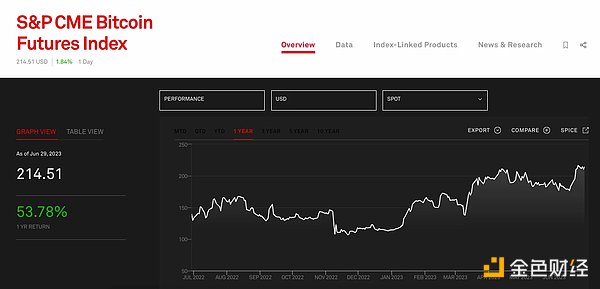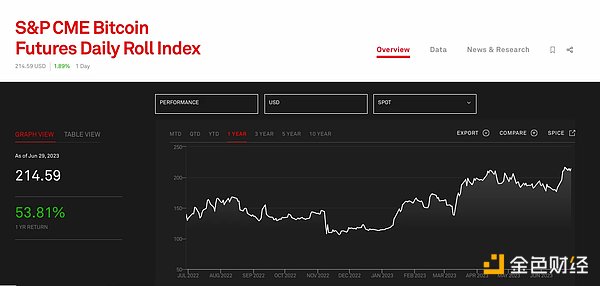Author: Qin Xiaofeng, Odaily Planet Daily

The first leveraged cryptocurrency ETF in the United States has been listed for three days, and its performance is lower than expected.
On June 27th (Tuesday), the “2x Bitcoin Strategy ETF” issued by the US ETF issuer Volatility Shares was officially listed on the BZX Exchange under CBOE and started trading.
- Multi-chain NFT presale platform launched by Magic Eden in collaboration with Helio
- Decentralized proof, proof market, and ZK infrastructure
- Stablecoin Market Outlook: LUSD Leads the Way
According to Odaily Planet Daily’s monitoring, 110,000 shares were issued on the first day of listing, with an issue price of $15, a net asset value of $1.65 million, and a first-day trading volume of $5.5 million, making it the best-performing cryptocurrency ETF on the first day of trading this year. (Odaily note: The first-day trading volume of Southern Dongying BTC Futures ETF was only $830,000, and Samsung Bitcoin ETF was only $98,000).
However, in the following two trading days, the trading volume of Volatility’s leveraged Bitcoin ETF began to plummet, with a daily trading volume of less than $300,000-only 21,768 shares were traded yesterday (29th), with a trading volume of $234,000. Its ETF issuance gradually increased, and the current circulation is 370,000 shares, with a net asset value of $5.7 million, as shown below:

What is a leveraged Bitcoin ETF? According to the application documents submitted by Volatility Shares to the SEC, the investment result sought by this ETF is equivalent to twice the excess return of the S&P CME Bitcoin Futures Daily Roll Index (referred to as the “Roll Index”) per day. For example, if the roll index rises by 1% per day, the net value of the ETF needs to rise by 2%. If the roll index falls by 1%, the net value of the ETF will fall by 2%.
The “Roll Index” is used to measure the performance of the CME Bitcoin futures market and is rebalanced every day between the current month futures contract and the next month futures contract. If you don’t understand, just know that the daily roll index of CME’s Bitcoin futures actually has the same data and trend as the CME Bitcoin futures index-both are affected by the trend of Bitcoin spot prices. As shown below:


Therefore, the leveraged ETF issued this time actually has the same benchmark index as the previously issued Bitcoin futures ETF, both of which are futures data.
To achieve the goal of doubling income, the ETF has set up a wholly-owned subsidiary with 25% of the total fund assets to invest in CME Bitcoin futures (to become long); the remaining assets will be directly invested in cash, cash-like instruments, or high-quality securities, including US government securities, money market funds, corporate debt securities, etc., which will be used for future liquidity or as margins.

The official website shows that the leveraged ETF currently holds CME Bitcoin futures expiring on July 23 with a value of $10.708 million, CME Bitcoin futures expiring on August 23 with a value of $626,000, and cash equivalents with a value of $5.69 million. From the proportion perspective, the total futures position is exactly twice the net asset value of the fund, which can meet the requirement of two times the leverage exposure risk.
However, I still believe that the market size of this leveraged ETF will not increase significantly.
First of all, the issuing node is not good, and homogeneous products do not have outstanding highlights. The 2x leveraged ETF is essentially a futures ETF, and the US market has already issued multiple Bitcoin futures ETFs such as ProShare, VanEck, Valkyrie, and Hashdex in the past two years. CME also launched Bitcoin futures long ago. As a latecomer, Volatility Shares seems a bit disappointing and does not have much first-mover advantage, as can be seen from the trading volume in the past two days.
Moreover, the management fee is an important factor that directly affects investors’ choices, and the management fee of Volatility Shares is relatively high among a group of ETFs. According to the statistics of Odaily Star Planet Daily, the Bitcoin futures ETF of Southern Dongying currently has the highest management fee in the ETF market, reaching 2%. The management fees of ETFs launched in the US and Canada in the past two years are generally around 1%. The management fee of Volatility Shares is as high as 1.85%, which is not attractive.
Finally, the failure cases of leveraged ETFs also sounded the alarm for Volatility Shares. As early as April 16, 2021, the world’s first cryptocurrency leveraged ETF-Beta Pro Bitcoin ETF (code: HBIT) was listed on the Toronto Stock Exchange. After going online, the ETF’s market performance was sluggish, with an average daily trading volume of only 5,769 shares (trading volume of $100,000) in the past year, and a total asset size of only $3.76 million; in mid-April this year, the issuer Horizons finally closed the ETF.
While there are limitations to the Canadian financial market itself, this also proves that leveraged ETFs do not have high development potential. This is especially true when compared to two spot ETFs that were launched in Canada during the same period – the Purpose BTC Spot ETF ($85.13 million) and the 3iQ BTC Spot ETF ($77.95 million) – which is enough to prove that only cryptocurrency spot ETFs have attraction to investors. This is also the reason why traditional investment institutions such as BlackRock, Fidelity, and ARK Investment have all applied for Bitcoin spot ETFs.
Like what you're reading? Subscribe to our top stories.
We will continue to update Gambling Chain; if you have any questions or suggestions, please contact us!